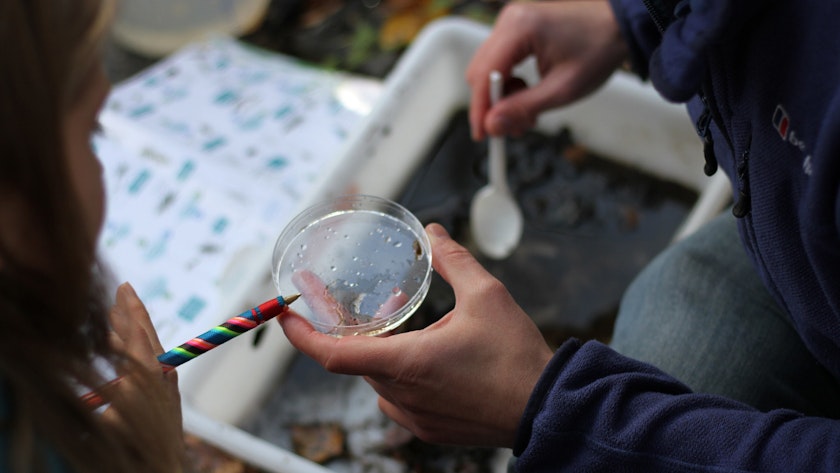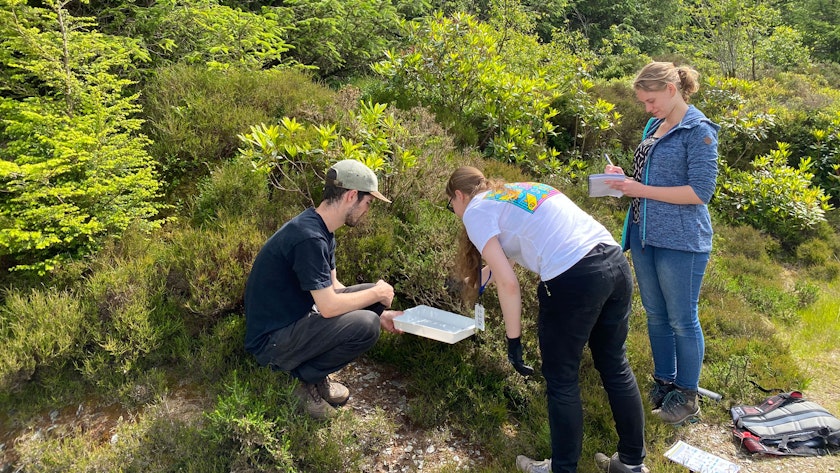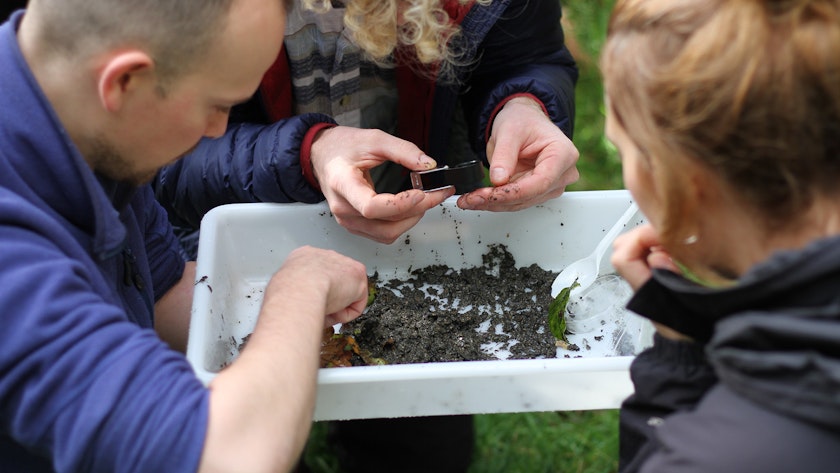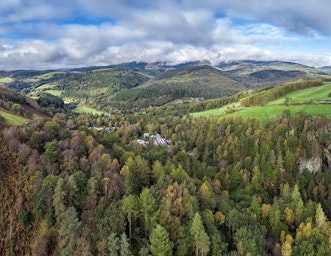
Next in our series looking at themes and topics explored by students on CAT Masters degrees, Dr Jane Fisher introduces ecological assessment and some of the main teaching methods used on our courses.
Ecological assessment is the measurement of the structure, quality and function of an ecosystem or, on a small scale, a habitat. It can involve measuring biodiversity (structure); a chemical variable, such as the concentration of a nutrient available in soil or water, or a metal contaminant (quality); or whether an ecosystem is effective in storing carbon or water to prevent flooding (function). Understanding these aspects is a key part of our MSc Sustainability and Ecology programme and also useful for students studying MSc Sustainable Food and Natural Resources.
Why is the topic important?
Ecological assessment is used in many aspects of natural resource management and to measure environmental change. It can establish academic information about an ecosystem, check adherence to policy and legislation relating to land management, and investigate whether management has had a desired impact on an ecosystem’s functioning or species diversity. For instance, when seeking to restore an ecosystem, how can we know if or when the work has been successful? What does a successful ecological restoration look like?
A current and growing practice is to pay a landowner to protect land. For example, a farmer might be paid to farm in environmentally sensitive ways. For payments to be linked to success, methods are needed to measure changing ecosystem variables. In the future, these measurements may be a defining aspect of how ecosystem protection is funded. This approach is called ‘payments for ecosystem services’ or PES. Underlying it is a need to be able to measure ecological health, and especially the ability of an ecosystem to provide services such as clean air, water, habitat for pollinators, or sequestering carbon.
An ecosystem that is intact and healthy provides value to the people who use or visit it, to people who value biodiversity itself, and to global-scale ecological health. We therefore need to be able to compare a healthy ecosystem with a degraded ecosystem on the same or a similar site. Ecological assessment is important for conservation and likely to lie at the heart of ecosystem protection approaches globally.

What are the main aspects to consider?
Ecosystems are complex interconnected webs of many organisms interacting via biogeochemical pathways. There are, therefore, a myriad of different ways an ecosystem can be assessed. Is the interest in biodiversity focused on the level of species, for instance asking how many different species there are? If so, are we interested in animal species? Insects? Microbes? Does identifying species even matter? Perhaps what the species ‘do’ matters more? Looking at the abundance of woody species, top predators, ecological engineers or microbial nitrogen-fixers, for example, could tell us more about the ecosystem and what is happening than merely making a list of species. Or, if looking at physico-chemical variables, there are literally thousands to choose from, and as many different ways to measure them. Measuring how well an ecosystem functions to provide services is similarly complex. How can we measure if an ecosystem cleans water, or is resilient to climate change, or makes people happy, for example?
One of the main challenges in ecological assessment methods is to know what we are aiming for and then to select methods that help us achieve that aim. These generally need to be simple, affordable and useable by ecologists all over the world with varied access to resources. But they also need to be reliable, so that they give answers about the ecosystem’s structure, function and health overall. This is the holy grail of finding ‘ecological indicators’.

What are the main teaching methods?
We begin by envisaging what a healthy ecosystem looks like, and what a damaged and degraded ecosystem might look like in comparison. We draw on academic research to support our discussions. We then focus on some commonly used and often globally relevant ecological assessment methods and get our hands dirty trying them out in the field. We sample invertebrates in the Dulas river at the bottom of the CAT site, carry out bird surveys in CAT’s woodland, Coed Gwern, and map habitat around the visitor centre.
While looking at the temperate aquatic and terrestrial ecosystems around CAT, we trial and critique methods that would be applicable to equivalent environments in tropical, dry Mediterranean or colder alpine environments. Our students joining us at distance, often from all over the globe, can also try these methods out and report back on their findings when we meet online.
Through this experiential learning, we can see which methods will require the ecologist to have specialist species identification skills or expensive scientific kit and which rely on a few easy-to-recognise species or physico-chemical characteristics. We also investigate which methods are multimetric, drawing on a range of species, chemical and physical information, and which are drawn from the understanding of local people and traditional ecological knowledge.
We then look to place our learning in wider contexts. At CAT, we like to ask the big questions to which there is no single answer. Is an ecosystem that appears healthy one that can withstand the pressures of climate change? How do we recognise, and value, an ecosystem that is resilient to disease? How do the results from local ecological assessment methods fit into global remote sensing and satellite image data on ecosystems? How do we incorporate the indigenous knowledge that local people have to enable a more holistic understanding? And what can we do with all this information?
After the module teaching period, the students work on their assignments. One of these is a consultancy-style report in which they assess a habitat of their choice, critique the ecological assessment methods they have chosen to use, and outline management recommendations for that site.

How do students use this learning?
Recent students have used the skills gained in this module when studying for their MSc dissertations, carrying out research into topics such as insect diversity in green roofs, bird communities related to the form of urban parks, and evaluating the probable success of seaweed bed restorations. Students have gone on to become advisers for Natural England, work with the National Trust, or become land managers for the Wildlife Trusts, as well as working for councils and environmental education providers. Others have gone on to further research towards a PhD, and have found that this hands-on experience, coupled with looking at the big picture, stands them in good stead for deeper study.
The issues covered in this module reflect a growing area of ecological assessment vital for the current EU Biodiversity Strategy for 2030 and for UK policy such as the UK government’s Biodiversity Net Gain Initiative and new farm payments which may, or may not, come about through the new Environmental Land Management schemes (ELMs). Preventing and mitigating the current global ecological collapse is going to take more students with hands-on ecological assessment skills, alongside big picture thinking and real-world problem solving.
About the author
Jane is Programme Leader for MSc Sustainability and Ecology and Sustainability and Behaviour Change, and developed the MSc Sustainable Food and Natural Resources programme. She has professional experience in developing ecological assessment methods to evaluate freshwater and wetland environments, a PhD in freshwater ecology, and has taught environmental science, biogeography and ecology at universities for over 15 years.
Study with us
Find out more about studying an MSc or MRes course at CAT, by joining an upcoming virtual open day on 28 April or an on-site open day on 19 May, before our application deadline on 31 May. Contact Alis to make an enquiry or call us on +44 (0)1654 705953
- Graduate School
- Nature and Wildlife
- News Feed
Related Topics
Related Pages
Related events


On-site Open Day: MSc & MRes Courses
17th May 2024
Graduate School Postgraduate Funding Webinar
20th May 2024
Virtual Open Day: MArch Sustainable Architecture Part 2
27th May 2024GRADUATE SCHOOL OF THE ENVIRONMENT
ACT NOW FOR A SUSTAINABLE FUTURE
Learn more about our exciting postgraduate courses and sign up for our emails to stay up-to-date on all the latest.

